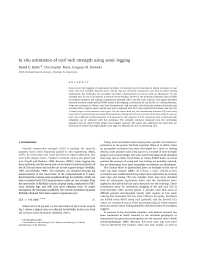Mining Publication: In Situ Estimation of Roof Rock Strength using Sonic Logging
Original creation date: September 2010
Sonic travel time logging of exploration boreholes is routinely used in Australia to obtain estimates of coal mine roof rock strength. Because sonic velocity logs are relatively inexpensive and easy to obtain during exploration, the technique has provided Australian underground coal mines with an abundance of rock strength data for use in all aspects of ground control design. However, the technique depends upon reliable correlations between the uniaxial compressive strength (UCS) and the sonic velocity. This paper describes research recently conducted by NIOSH aimed at developing a correlation for use by the U.S. mining industry. From two coreholes in Illinois, two from Pennsylvania, and one each from Colorado, western Kentucky and southern West Virginia, sonic velocity logs were compared with UCS values derived from Point Load tests for a broad range of coal measure rock types. For the entire data set, the relationship between UCS and sonic travel time is expressed by an exponential equation relating the UCS in psi to the travel time of the P-wave in mu s/ft. The coefficient of determination or R-squared for this equation is 0.72, indicating that a relatively high reliability can be achieved with this technique. The strength estimates obtained from the correlation equation may be used to help design roof support systems. The paper also addresses the steps that are necessary to ensure that high-quality sonic logs are obtained for use in estimating UCS.
Authors: DC Oyler, C Mark, GM Molinda
Peer Reviewed Journal Article - September 2010
NIOSHTIC2 Number: 20037712
Int J Coal Geol 2010 Sep; 84(4):484-490
See Also
- Considerations for Using Roof Monitors in Underground Limestone Mines in the USA
- Correlation of Sonic Travel Time to the Uniaxial Compressive Strength of U.S. Coal Measure Rocks
- Development of a Statistical-Analytical Approach for Assessing Coal Bump Potential
- Effects of Stimulation Treatments on Coalbeds and Surrounding Strata: Evidence from Underground Observations
- Field Observations and Numerical Studies of Horizontal Stress Effects on Roof Stability in U.S. Limestone Mines
- In-depth Survey Report: Control Technology for Environmental Enclosures - The Effect of Wind Speed Upon Aerosol Penetration Into an Enclosure at Clean Air Filter, Defiance, IA
- New Developments with the Coal Mine Roof Rating
- Roof Span Design for Underground Stone Mines
- Spatial Trends in Rock Strength - Can They Be Determined From Coreholes?
- Technology News 481 - Update: Roof Monitoring Safety System for Underground Stone Mines
- Content source: National Institute for Occupational Safety and Health, Mining Program


 ShareCompartir
ShareCompartir
